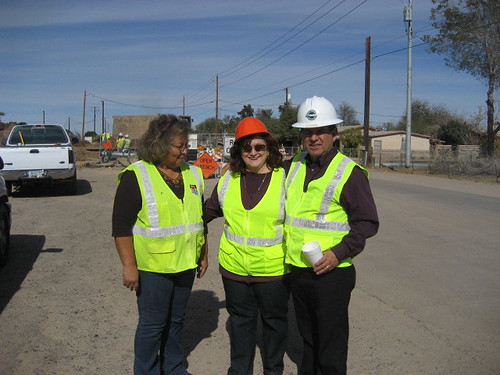
“YES! YES! YES!”
Larry Bagby was giddy as he lifted his 69-year old frame into an exuberant leap and repeated those words. Those words, he explained, were his initial response a few years ago when asked if he would support a neighborhood effort to hook up to a real wastewater system.
It seems sewage has been a focal point in the area known as Avenue B&C Colonia, since the Colonia began. Bagby should know. He owns the first house ever built there.
Bagby’s folks had come to the area in a Ford flatbed truck in 1936. They were planning to go to California, but only got as far as the Colorado River. They decided it was as good a place as any to settle down. Soon, like most of the people in the area, they were cutting lettuce in the vast fields of the fertile Colorado River region.
When Larry’s dad returned home after World War II he bought a parcel in the area that is now the Colonia. The family lived in a tent with an outhouse. They had no electricity and no running water. They also had no cooling, which is a real issue in an area where the summertime high temperature averages 100 degrees.
In 1955 Larry’s dad finally built a home on the land. The family had running water, electricity, a swamp cooler…and a brick cesspool.
In the mid 60’s Larry came home from his military tour to find the family had a brand new concrete septic tank. The tank was a real improvement from the outhouse and cesspool, but it had its problems as well.
“We’d have many times when the septic tank would get full, especially with all the kids around. We wouldn’t be able to flush until we could get someone out to get it pumped,” he said.
These days, Avenue B & C Colonia is a community of around 1,000 homes. It consists of mostly trailers and modest houses. A stable neighborhood, the Colonia has a core of other longtime residents for whom it is not only home, but also a beloved community.
One of those other residents is Gayle Castricone.
Gayle was one of the activists who spent several years gathering those petition signatures from Larry, Richard and the other neighbors to try to get some help in fixing the chronic sewage problems that plagued the residents in the Colonia.
“There were times when sewage would bubble right out of the ground here,” says Castricone. “I raised my children in this Colonia. I wanted my grandchildren to be able to play in the neighborhood without worrying about health hazards.”
The septic system failures contaminated the Colonia’s air and ground, but they presented much more than an aesthetic problem. Located only half a mile from the Colorado River, the Colonia’s septic tanks leach in an area where the water table can rise sharply during irrigation of nearby farm land. The water table rises and the sewage percolates down creating a potential perfect storm which threatened the river itself.
Castricone says that nearly all of the neighbors were motivated about getting hooked up to a real sewer system. “We knew we would have to fight for this and fight to get money to pay for it,” she said. “We said we’ll have bake sales or whatever.” When the project planners announced the $23 million price tag, the neighbors knew that they needed more than a bake sale. They needed a miracle.
Castricone says that “miracle” unfolded when county, state, federal and private funding sources partnered to create a package that is funding the entire project.
Using an American Recovery and Reinvestment (Recovery Act) grant funds through USDA Rural Development (RD), Yuma County is now building a collection system to hook the Colonia up to the nearby waste treatment plant. The project also received a loan from RD and additional funding from the Border Environment Cooperation Commission, NADBank and the Environmental Protection Agency.
Today in the Colonia, the old failing systems are being removed as the project progresses and homes are being fitted for the new hook up.
Just before Thanksgiving, Richard Eddy’s home was connected. He says it’s been great. Larry Bagby has been connected now for about a month. He couldn’t be happier, praising Yuma County and other project officials.
The only thing that seems to bubbling out now in the Colonia is goodwill.
To find out how USDA can assist your community in meeting its water and environmental needs click here.


